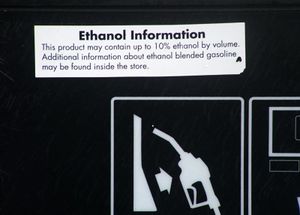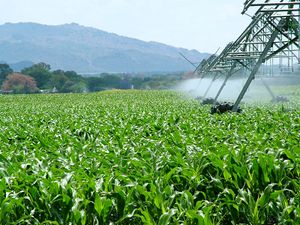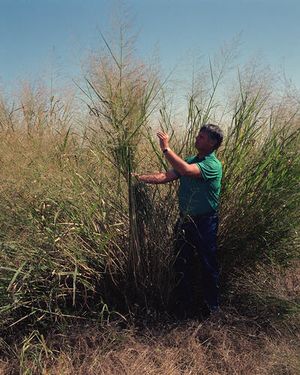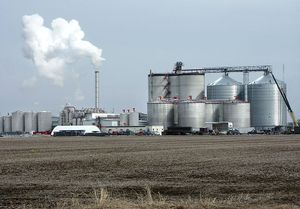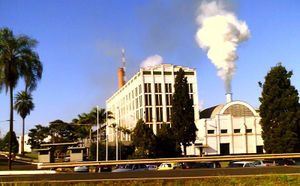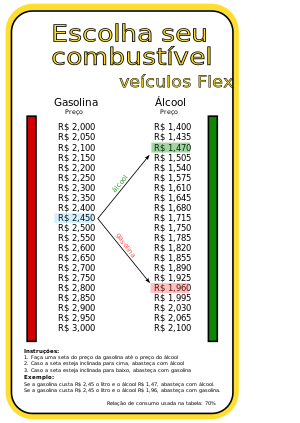إيثانول حيوي
| الطاقة المتجدّدة |
|---|
| طاقة حيوية كتلة حيوية طاقة حرارية أرضية طاقة مائية طاقة شمسية طاقة المد والجزر طاقة موجية طاقة الرياح |
الإيثانول الحيوي أو البيو-إيثانول بالإنجليزية Ethanol fuel ، هو إيثيل كحولى يتم إنتاجه عن طريق تخمير السكريات الموجودة في لقيم من الحبوب كالذرة و القمح أو من النباتات المنتجة للسكر كقصب السكر ويستخدم في السيارات التى تعمل بالبنزين بنسب خلط تصل إلى15% بيو إيثانول بدون أى تعديل في تصميم المحرك. ولا يعتبر الايثانول وقوداً جديدا حيث كان الوقود الأساسى المستخدم في الاضاءة منذ عام 1850 ، وفى عام 1908 استخدم هنرى فورد مزيج من البنزين والايثانول في نموذجه الاختبارى الأول ، ولقد زاد استخدام الايثانول مؤقتاً خلال الحرب العالمية الثانية وزاد الاهتمام باستخدام الايثانول كوقود في السبعينات عندما خفضت معظم الدول المصدرة للبترول إمداداتها من البنزين. وفى عام 1980 بدأ إضافة الايثانول للبنزين لخفض انبعاثات أول أكسيد الكربون.
. . . . . . . . . . . . . . . . . . . . . . . . . . . . . . . . . . . . . . . . . . . . . . . . . . . . . . . . . . . . . . . . . . . . . . . . . . . . . . . . . . . . . . . . . . . . . . . . . . . . . . . . . . . . . . . . . . . . . . . . . . . . . . . . . . . . . . . . . . . . . . . . . . . . . . . . . . . . . . . . . . . . . . . .
التركيب الكيميائي
أثناء تخمر الإيثانول, يتفكك الگلوكوز إلى إيثانول و ثاني اكسيد الكربون.
- C6H12O6 → 2C2H6O + 2CO2
أثناء الاحتراق يتفاعل الإيثانول مع الأكسجين لإنتاج ثاني اكسيد الكربون والماء وحرارة: (ملوثات أخرى للجو تنتـُج أيضاً عند يـُحرق الإيثانول في الهواء الجوي بدلاً من أكسجين نقي)
- C2H6O + 3O2 → 2CO2 + 3H2O
ومعاً, يـشكلان:
- C6H12O6 + 6O2 → 6CO2 + 6H2O + heat
التحضير

إن طريقة تحضير الإيثانول تختلف بين المختبر وبين المصانع الكبيرة، ولكن في هذا الجزء سوف نفسر طريقة الإستخراج ، التي يمكن أن نقوم بها في المختبرات العادية ( مختبرات الجامعة مثلا)، و العملية تتألف من أربعة مراحل:
- نقوم بطحن حبوب الذرة أو القمح في جرن، والهدف من تلك العملية هو استخراج النشا الموجود فيهما.
- يتم مزج الحبوب المستخرجة مع الماء و يسخنان قليلا، و من ثم نضيف الأنزيم المختص ، أو الكفيل بتحويل النشاء إلى سكروز ، عبر عملية كيميائية تسمى "التحليل المائي".
- نضيف على السكروز ، الخميرة الكفيلة بتحويل السكروز إلى الإيثانول.
- ومن ثم يتم عزل الإثانول من الخليط ، عبر عملية التقطير ، و أما التخلص من الماء المتبقي فيتم عبر عملية التجفيف، أو عبر زيادة الملح على الخليط ، حيث تقوم جزيئات الملح بالتجمع حول جزيئات الماء، و تحبس جزيئات الماء.
حاليا تتركز الأبحاث حول طرق استخراج الإيثانول من مصادر أخرى كبقايا الأخشاب أو المحاصيل الزراعية.
التحضير الصناعي
يمكن تطبيق هذه العملية للإنتاج الصناعي ، فهي عملية كاملة متكاملة من كافة النواحي ، فبقايا عملية الإستخراج يمكن إستعمالها كعلف للحيوانات ، و بالتالي ليس هنالك بقايا مضرة للطبيعة أو الإنسان على حد سواء من هذه العملية.
وأما تطبيقها على صعيد واسع فهو ممكن جدا و ذلك نظرا للأرقام التالية:
هكتار من الحبوب 2.16 طن من البيو-إثانول 3 طن من البقايا التي يمكن إستعمالها كطعام للماشية هكتار من الشمندر 6 طن من البيو-إثانول 3.75 طن من البذور الجافة التي يمكن إستعمالها كطعام للماشية
التكنولوجيا
الإيثانول والمحركات
Ethanol is most commonly used to power automobiles, though it may be used to power other vehicles, such as farm tractors and airplanes. Ethanol (E100) consumption in an engine is approximately 34% higher than that of gasoline (the energy per volume unit is 34% lower).[1][2] However, higher compression ratios in an ethanol-only engine allow for increased power output and better fuel economy than would be obtained with the lower compression ratio.[3][4] In general, ethanol-only engines are tuned to give slightly better power and torque output to gasoline-powered engines. In flexible fuel vehicles, the lower compression ratio requires tunings that give the same output when using either gasoline or hydrated ethanol. For maximum use of ethanol's benefits, a much higher compression ratio should be used,[5] which would render that engine unsuitable for gasoline use. When ethanol fuel availability allows high-compression ethanol-only vehicles to be practical, the fuel efficiency of such engines should be equal or greater than current gasoline engines. However, since the energy content (by volume) of ethanol fuel is less than gasoline, a larger volume of ethanol fuel (151%) would still be required to produce the same amount of energy.[6]
A 2004 MIT study,[7] and an earlier paper published by the Society of Automotive Engineers,[8] describing tests, identify a method to exploit the characteristics of fuel ethanol that is substantially better than mixing it with gasoline. The method presents the possibility of leveraging the use of alcohol to even achieve definite improvement over the cost-effectiveness of hybrid electric. The improvement consists of using dual-fuel direct-injection of pure alcohol (or the azeotrope or E85) and gasoline, in any ratio up to 100% of either, in a turbocharged, high compression-ratio, small-displacement engine having performance similar to an engine having twice the displacement. Each fuel is carried separately, with a much smaller tank for alcohol. The high-compression (which increases efficiency) engine will run on ordinary gasoline under low-power cruise conditions. Alcohol is directly injected into the cylinders (and the gasoline injection simultaneously reduced) only when necessary to suppress ‘knock’ such as when significantly accelerating. Direct cylinder injection raises the already high octane rating of ethanol up to an effective 130. The calculated over-all reduction of gasoline use and CO2 emission is 30%. The consumer cost payback time shows a 4:1 improvement over turbo-diesel and a 5:1 improvement over hybrid. In addition, the problems of water absorption into pre-mixed gasoline (causing phase separation), supply issues of multiple mix ratios and cold-weather starting are avoided.
Ethanol's higher octane rating allows an increase of an engine's compression ratio for increased thermal efficiency.[9] In one study, complex engine controls and increased exhaust gas recirculation allowed a compression ratio of 19.5 with fuels ranging from neat ethanol to E50. Thermal efficiency up to approximately that for a diesel was achieved.[10] This would result in the MPG (miles per gallon) of a dedicated ethanol vehicle to be about the same as one burning gasoline.
Engines using fuel with from 30% to 100% ethanol also need a cold-starting system. For E85 fuel at temperatures below 11 °C (52 °F) a cold-starting system is required for reliable starting and to meet EPA emissions standards.[11] However, the EPA does not require cold start systems on E85 vehicles. No current production E85 vehicles in the USA are equipped with these cold start systems, and they meet EPA emission guidelines.[بحاجة لمصدر]
خلطات وقود الإيثانول
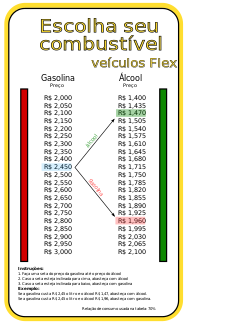
To avoid engine stall due to "slugs" of water in the fuel lines interrupting fuel flow, the fuel must exist as a single phase. The fraction of water that an ethanol-gasoline fuel can contain without phase separation increases with the percentage of ethanol.[12]. This shows, for example, that E30 can have up to about 2% water. If there is more than about 71% ethanol, the remainder can be any proportion of water or gasoline and phase separation will not occur. However, the fuel mileage declines with increased water content. The increased solubility of water with higher ethanol content permits E30 and hydrated ethanol to be put in the same tank since any combination of them always results in a single phase. Somewhat less water is tolerated at lower temperatures. For E10 it is about 0.5% v/v at 70 F and decreases to about 0.23% v/v at -30 F.[13]
In many countries cars are mandated to run on mixtures of ethanol. Brazil requires cars be suitable for a 25% ethanol blend, and has required various mixtures between 22% and 25% ethanol, as of October 2006 23% is required. The United States allows up to 10% blends, and some states require this (or a smaller amount) in all gasoline sold. Other countries have adopted their own requirements. Beginning with the model year 1999, an increasing number of vehicles in the world are manufactured with engines which can run on any fuel from 0% ethanol up to 100% ethanol without modification. Many cars and light trucks (a class containing minivans, SUVs and pickup trucks) are designed to be flexible-fuel vehicles (also called dual-fuel vehicles). In older model years, their engine systems contained alcohol sensors in the fuel and/or oxygen sensors in the exhaust that provide input to the engine control computer to adjust the fuel injection to achieve stochiometric (no residual fuel or free oxygen in the exhaust) air-to-fuel ratio for any fuel mix. In newer models, the alcohol sensors have been removed, with the computer using only oxygen and airflow sensor feedback to estimate alcohol content. The engine control computer can also adjust (advance) the ignition timing to achieve a higher output without pre-ignition when it predicts that higher alcohol percentages are present in the fuel being burned. This method is backed up by advanced knock sensors - used in most high performance gasoline engines regardless if they're designed to use ethanol or not - that detect pre-ignition and detonation.
الوقود الإقتصادي
. . . . . . . . . . . . . . . . . . . . . . . . . . . . . . . . . . . . . . . . . . . . . . . . . . . . . . . . . . . . . . . . . . . . . . . . . . . . . . . . . . . . . . . . . . . . . . . . . . . . . . . . . . . . . . . . . . . . . . . . . . . . . . . . . . . . . . . . . . . . . . . . . . . . . . . . . . . . . . . . . . . . . . . .
الدول المنتجة
The top five ethanol producers in 2006 were the United States with 4.855 billion U.S. liquid gallons (bg), Brazil (4.49 bg), China (1.02 bg), India (0.50 bg) and France (0.25 bg).[14] Brazil and the United States accounted for 70 percent of all ethanol production, with total world production of 13.5 billion US gallons (40 million tonnes). When accounting just for fuel ethanol production in 2007, the U.S. and Brazil are responsible for 88% of the 13.1 billion gallons total world production. Strong incentives, coupled with other industry development initiatives, are giving rise to fledgling ethanol industries in countries such as تايلند, Colombia, and some Central American countries. Nevertheless, ethanol has yet to make a dent in world oil consumption of approximately 4000 million tonnes/yr (84 million barrels/day).[15]
| الإنتاج السنوي للإيثانولProduction (All Grades) حسب البلد (2004-2006)[14] أعلى 15 countries (مليونجالون) |
الإنتاج السنوي لوقود الإيثانول بالبلد(2004-2006)[16] Top 15 countries/blocks (Millions of U.S. liquid gallons) | ||||||
|---|---|---|---|---|---|---|---|
| World rank |
البلد | 2006 | 2005 | 2004 | العالم rank |
البلدة/الإقليم | 2007 |
| 1 | 4,855 | 4,264 | 3,535 | 1 | 6,498.6 | ||
| 2 | 4,491 | 4,227 | 3,989 | 2 | 5,019.2 | ||
| 3 | 1,017 | 1,004 | 964 | 3 | 570.3 | ||
| 4 | 502 | 449 | 462 | 4 | 486.0 | ||
| 5 | 251 | 240 | 219 | 5 | 211.3 | ||
| 6 | 202 | 114 | 71 | 6 | 79.2 | ||
| 7 | 171 | 198 | 198 | 7 | 74.9 | ||
| 8 | 153 | 61 | 61 | 8 | 52.8 | ||
| 9 | 122 | 93 | 79 | 9 | Central America | 39.6 | |
| 10 | 102 | 103 | 110 | 10 | 26.4 | ||
| 11 | 93 | 79 | 74 | 11 | 15.8 | ||
| 12 | 74 | 92 | 106 | 12 | 9.2 | ||
| 13 | 71 | 65 | 66 | 13 | 7.9 | ||
| 14 | 66 | 58 | 53 | 14 | 5.2 | ||
| 15 | 52 | 32 | 79 | 15 | 4.7 | ||
| World Total | 13,489 | 12,150 | 10,770 | World Total | 13,101.7 | ||
. . . . . . . . . . . . . . . . . . . . . . . . . . . . . . . . . . . . . . . . . . . . . . . . . . . . . . . . . . . . . . . . . . . . . . . . . . . . . . . . . . . . . . . . . . . . . . . . . . . . . . . . . . . . . . . . . . . . . . . . . . . . . . . . . . . . . . . . . . . . . . . . . . . . . . . . . . . . . . . . . . . . . . . .
البرازيل
الولايات المتحدة
وفي هذا الخصوص، خصصت وزارة الطاقة الأمريكية في فبراير/شباط الماضي، 385 مليون دولار لستة مشاريع على مدى أربع سنوات بهدف إنتاج إيثانول سيليلوزي وتجنب أزمة الذرة عن طريق إنتاج الوقود من القصب وغيرها من المخلفات الزراعية.
وكانت تكلفة إنتاج الإنزيم المستخدم في صناعة وقود الإيثانول الكبيرة سبباً في عدم إنتاجه بكميات كبيرة، غير أن انخفاض تكلفة الإنزيم من نحو خمسة دولارات للغالون الواحد إلى أقل من 20 سنتاً جعل الأمر ممكناً، وسوف يصبح والإيثانول السيليلوزي متاحاً بصورة أكبر مع انخفاض التكلفة إلى أقل من سنت واحد. [17]
توقعت دراسات أمريكية متخصصة، أن يشهد موسم القمح الأمريكي هذا العام محصولاً قياسياً، بعدما عمد عدد كبير من المزارعين الأمريكيين الى تخصيص أراضيهم لزراعته مدفوعين بالارتفاع الكبير المتوقع في الأسعار، على خلفية الطلب المتزايد على الحبوب لإنتاج وقود الإيثانول.
وقد أكد تقرير صادر عن وحدة الدراسات الاقتصادية بوزارة الزراعة الأمريكية هذه التوقعات، كاشفاً أن مجموعة من العوامل تضافرت هذا العام لتسجيل موسم لم يسبق له مثيل من حيث الحجم والأسعار بتاريخ البلاد.
وأظهرت الدراسة أن الطلب على القمح تزايد هذا العام بشكل رئيسي، بسبب موجة الجفاف التي ضربت الأراضي العام الماضي، مما شكل ضغطاً كبيراً على احتياطي الحبوب الأمريكي إلى جانب تراجع موجة الحميات الغذائية التي تستبعد الخبز من قوائم طعامها.
كما أشارت الى ان عدداً كبيراً من مربي الماشية يبحثون حالياً عن مواد جديدة لاستخدامها علفاً لحيواناتهم هذا الموسم، مع الارتفاع الكبير الذي شهدته أسعار القمح في الأسواق، علماً أنهم كانوا يعتزمون استخدام هذه المادة كبديل عن الذرة التي باتت "الذهب الزراعي" الجديد.
ولفتت وزارة الزراعة الأمريكية إلى أن سعر كيلو القمح الواحد (يوازي ثمانية غالونات) سيبلغ 4.30 دولاراًَ، بفارق بسيط عن أعلى سعر وصلت إليه هذه المادة وهو 4.55 دولاراًَ عام 1995 - 1996 وذلك بالرغم من أن محصول هذا العام أضخم بكثير من محصول السنوات الماضية في أمريكا والعالم.
وكان مزارعو الولايات المتحدة قد عمدوا إلى مضاعفة الأراضي الزراعية المخصصة للقمح الخريف الماضي، بعدما بلغت الأسعار حداً غير مسبوق في تلك الفترة وفقاًَ للأسوشيتد برس.
وقد خصصت مساحة 3.5 ملايين إيكر إضافي لزراعة القمح الشتوي، أضيفت إلى المساحات الشاسعة التي أُعيد زراعتها هذا العام بعدما حالت موجات الجفاف دون ذلك العام الماضي، مما سيرفع إجمالي الأراضي الزراعية المخصصة للقمح هذا الموسم إلى 60 مليون إيكر.
وتوقعت التقارير أن تخصص النسبة الأكبر من الإنتاج المحلي للاستهلاك الداخلي، مع ارتفاع الحاجات المحلية وانخفاض الطلب الخارجي المترافق مع التوسع المتزايد في زراعة القمح حول العالم.
يذكر أن الطاقة البديلة باتت هاجس الإدارة الأمريكية الجديد لأسباب سياسية واقتصادية وقد شكلت المحور الأساسي لجولة جورج بوش إلى أمريكا الجنوبية حيث وقّع مع نظيره البرازيلي: "اتفاقية الإيثانول."
وقد قال بوش آنذاك أن زيارته تهدف لتشكيل تحالف للدول المصدرة للإيثانول، والترويج لإنتاج الوقود المستخرج من الذرة في أمريكا الوسطى ودول الكاريبي، لمواجهة زيادة الطلب على هذا الوقود الحيوي.
الا أن بعض الخبراء يحذرون من أنه قد يؤدي الى معاناة كثير من البشر الجوع بسبب ارتفاع أسعار الطعام.
ويتنبأ بعض الخبراء بتغير دائم في اقتصاديات الغذاء اذا حصل المزارعون على أرباح من المحاصيل التي ستخصص للوقود أعلى من تلك التي يحصلون عليها اذا ما زرعوا محاصيل لاطعام البشر.
ويقول خبير امدادات الاغاثة الغذائية البريطاني ادوارد كلاي "نحن نشهد بنية جديدة للاسواق." وأضاف "قد تكون لها تأثيرات عميقة على الفقراء."
إيثانول الوقود (2001 - 2007)[14] (بالمليون گالون سائل أمريكي) | |||
|---|---|---|---|
| السنة | الانتاج | الاستيراد | الطلب |
| 2001 | 1,770 | n/a | n/a |
| 2002 | 2,130 | 46 | 2,085 |
| 2003 | 2,800 | 61 | 2,900 |
| 2004 | 3,400 | 161 | 3,530 |
| 2005 | 3,904 | 135 | 4,049 |
| 2006 | 4,855 | 653 | 5,377 |
| 2007 | 6,485 | 435 | 6,847 |
| ملاحظة: أرقام الطلب تتضمن stocks change والصادرات الصغيرة في 2005 | |||
أوروبا
| انتاج الإيثانول الحيوي في | |||
|---|---|---|---|
| رقم | الدولة | 2006 | 2005 |
| 1 | 2,554 | 978 | |
| 2 | 2,382 | 1,796 | |
| 3 | 1,482 | 853 | |
| 4 | 830 | 907 | |
| 5 | 759 | 47 | |
| 6 | 711 | 379 | |
| 7 | 201 | 207 | |
| 8 | 107 | 47 | |
| 9 | 89 | 47 | |
| 10 | 89 | 0 | |
| 11 | 71 | 71 | |
| 12 | 0 | 77 | |
| 27 | الإجمالي | 9,274 | 5,411 |
| 100 l بيو إيثانول = 79,62 كگ, 1 طن بيو إيثانول = 0,64 toe
| |||
| استهلاك البيو إيثانول في | |||
|---|---|---|---|
| رقم | الدولة | 2006 | 2005 |
| 1 | 3,573 | 1,682 | |
| 2 | 1,895 | 1,681 | |
| 3 | 1,747 | 871 | |
| 4 | 1,332 | 1,314 | |
| 5 | 611 | 329 | |
| 6 | 561 | 502 | |
| 7 | 238 | 0 | |
| 8 | 125 | 28 | |
| 9 | 99 | 10 | |
| 10 | 14 | 0 | |
| 11 | 9 | 0 | |
| 12 | 8 | 0 | |
| 13 | 0 | 59 | |
| 14 | 0 | 5 | |
| 27 | الاتحاد الاوروبي | 10,210 | 6,481 |
| 1 طن بيو إيثانول toe = 11,63 م و س MWh | |||
آسيا
الصين
تروج الصين وقوداً أساسه الإيثانول في مشروع تجريبي في خمس مدن في المنطقة الوسطى والشمالية الشرقية, وهي خطوة يـُرجا منها خلق سوقٍ جديدة لفائض محاصيل الحبوب فيها ولتخفيض استهلاك النفط. المدن هي جـِنگ جو و لويانگ ونان يانگ في ولاية هـِنان بوسط الصين, و هاربين و جاو دونگ في ولاية هـِيْ لونگ جيانگ, بشمال شرق الصين. وحسب البرنامج, ستروج هـِنان لوقود الإيثانول في جميع أنحاء الولاية بنهاية هذا العام. ويقول المسئولون أن تلك الخطوة هي في غاية الأهمية في المساعدة على استقرار أسعار الحبوب, ورفع دخل المزارعين وخفض تلوث الجو الناتج عن استخدام النفط.[19]
تايلند
تستخدم تايلاند بالفعل 10% ethanol (E10) widely on big scale on the local market. Begin this year they started with the sell of E20 and the in the third quarter of 2008 E85 will come on the mark.
أوقنيسيا
أستراليا
Legislation in Australia imposes a 10% cap on the concentration of fuel ethanol blends. Blends of 90% unleaded petrol and 10% fuel ethanol are commonly referred to as E10. E10 is available through service stations operating under the BP, Caltex, Shell and United brands as well as those of a number of smaller independents. Not surprisingly, E10 is most widely available closer to the sources of production in Queensland and New South Wales. E10 is most commonly blended with 91 RON "regular unleaded" fuel. There is a requirement that retailers label blends containing fuel ethanol on the dispenser.
أمريكا الوسطى والكاريبي
imports by country (2002-2007)[14] (Millions of U.S. liquid gallons) | ||||||
|---|---|---|---|---|---|---|
| Country | 2007* | 2006 | 2005 | 2004 | 2003 | 2002 |
| 188.8 | 433.7 | 31.2 | 90.3 | 0 | 0 | |
| 75.2 | 66.8 | 36.3 | 36.6 | 39.3 | 29.0 | |
| 73.3 | 38.5 | 23.7 | 5.7 | 6.9 | 4.5 | |
| 42.7 | 24.8 | 10.0 | 0 | 0 | 0 | |
| 39.3 | 35.9 | 33.4 | 25.4 | 14.7 | 12.0 | |
| *Note: 2007 figures through November only. | ||||||
جواتيمالا
السلفادور
كوستا ريكا
مقارنة بين إنتاج البرازيل والولايات المتحدة
| مقارنة المميزات الأساسية بين صناعة الإيثانول في الولايات المتحدة ونظيرتها في البرازيل | |||
|---|---|---|---|
| Characteristic | الوحدات/تعليقات | ||
| علف حيواني | قصب السكر | الأذرة | المحصول النقدي الرئيسي لإنتاج الإيثانول, الولايات المتحدة لديها أقل من 2% من المحاصيل الأخرى. |
| إجمالي انتاج الإيثانول (2007) [14] | 5,019.2 | 6,498.6 | Million U.S. liquid gallons |
| إجمالي الأرض القابلة للزراعة [20] | 355 | 270(1) | Million hectares. |
| إجمالي المساحة المستخدمة في محصول الإيثانول [20][21] | 3.6 (1%) | 10 (3.7%) | Million hectares (% total arable) |
| الإنتاجية للهكتار [20][22][21] | 7,500 | 4,000 | Liters of ethanol per hectare. Brazil is 727 to 870 gal/acre (2006), US is 424 gal/acre (2006) |
| توازن الطاقة (انتاجية الطاقة المـُدخـَلة) [23][21][24] | 8.3 to 10.2 times | 1.3 to 1.6 times | Ratio of the energy obtained from ethanol to the energy expended in its production |
| الخفض المتوقع في الإنبعاث الحراري [25][21][26] | 86-90%(2) | 10-30%(2) | % GHGs avoided by using ethanol instead of gasoline, using existing crop land. |
| محطات التموين بالإيثانول في البلد[22][27] | 33,000 (100%) | 873 (0,5%) | As % of total fueling gas stations in the country. U.S. has 170,000 (see Inslee, op cit pp. 161) |
| إيثانول الوقود المستخدم في قطاع النقل بالطرق [28][29] | 20%(3) | 3.6% | كـ % من إجمالي القطاع على أساس حجمي لسنة 2006. |
| تكلفة الإنتاج (USD/گالون) [22] | 0.83 | 1.14 | 2006/2007 للبرازيل (22¢/لتر), 2004 للولايات المتحدة (35¢/لتر) |
| الدعم الحكومي (بالدولار الأمريكي) [20][27] | 0 | 0.51/گالون | U.S. as of 2008-04-30. Brazilian ethanol production is no longer subsidized. |
| رسوم الإستيراد (بالدولار الأمريكي) [23][22] | 0 | 0.54/گالون | As of April 2008, Brazil does not import ethanol, the U.S. does |
| ملاحظات: (1) فقط للولايات المتجاورة, مستبعداً ألاسكا. (2) بافتراض عدم تغير استعمال الأراضي. [26] (3) باستبعاد العربات المدارة بالديزل, استهلاك الإيثانول في قطاع الطرق هو أكثر من 40% [22][27] | |||
البيئة
توازن الطاقة
| Country | Type | Energy balance |
|---|---|---|
| Corn ethanol | 1.3 | |
| Sugarcane ethanol | 8 | |
| Biodiesel | 2.5 | |
| No current production | Cellulosic ethanol | †2–36 |
† depending on production method
تلوث الهواء
التأثير على المحاصيل الشائعة
| Crop | Annual yield (Liters/hectare) | Annual yield (US gal/acre) | Greenhouse-gas savings (% vs. petrol) | Comments |
|---|---|---|---|---|
| Miscanthus | 7300 | 780 | 37–73 | Low-input perennial grass. Ethanol production depends on development of cellulosic technology. |
| Switchgrass | 3100–7600 | 330–810 | 37–73 | Low-input perennial grass. Ethanol production depends on development of cellulosic technology. Breeding efforts underway to increase yields. Higher biomass production possible with mixed species of perennial grasses. |
| Poplar | 3700–6000 | 400–640 | 51–100 | Fast-growing tree. Ethanol production depends on development of cellulosic technology. Completion of genomic sequencing project will aid breeding efforts to increase yields. |
| Sugar cane | 5300–6500 | 570–700 | 87–96 | Long-season annual grass. Used as feedstock for most bioethanol produced in Brazil. Newer processing plants burn residues not used for ethanol to generate electricity. Only grows in tropical and subtropical climates. |
| Sweet sorghum | 2500–7000 | 270–750 | No data | Low-input annual grass. Ethanol production possible using existing technology. Grows in tropical and temperate climates, but highest ethanol yield estimates assume multiple crops per year (only possible in tropical climates). Does not store well.[31][32][33][34] |
| Corn | 3100–3900 | 330–420 | 10–20 | High-input annual grass. Used as feedstock for most bioethanol produced in USA. Only kernels can be processed using available technology; development of commercial cellulosic technology would allow stover to be used and increase ethanol yield by 1,100 - 2,000 litres/ha. |
| Source (except sorghum): Nature 444 (December 7, 2006): 670-654. | ||||
تقليل الصادر من البترول
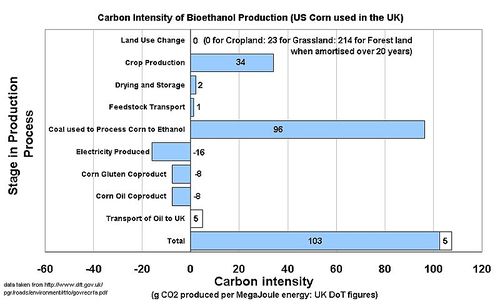
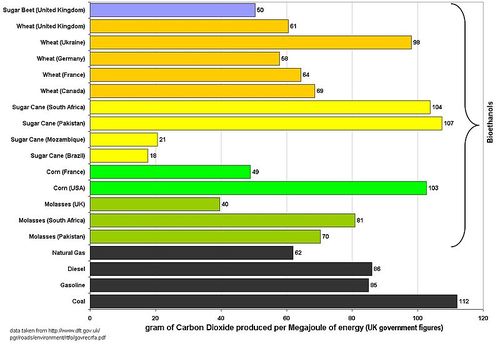
براءات الإختراع الأخيرة
الجدل والإنتقادات
مشاكل نظم الوقود
إيثانول من الطحالب
تعتزم شركة أمريكية خاصة انتاج الايثانول ، الذي يستخدم كوقود، من الطحالب مما يقلل الضغط على اسعار الغذاء نتيجة استخدام الذرة والقصب لانتاج هذه المادة.
فقد وقعت شركة الجينول اتفاقية بقيمة 850 مليون دولار مع شركة بيوفيلدز المكسيكية لاستزراع الطحالب بطريقة تجعلها تحول المياه وضوء الشمس و ثاني أكسيد الكربون الى وقود حيوي.
وفي مقابلة مع وكالة رويترز للانباء قال رئيس الجينول بول وودز انه يعرف تلك التكنولوجيا منذ سنوات لكن ارتفاع اسعار النفط الان يجعل الوقت مناسبا لاستخدامها.
وتحاول بعض الشركات التي تعمل في الطحالب دخول مجال الوقود الحيوي بتجفيف وضغط تلك الكائنات الاولية لانتاج زيت الخضروات الذي يعالج ليصبح ديزل حيوي.
الا ان وودز يقول ان شركته ستجعل خلايا الطحالب تفرز الايثانول الذي سيتم تجميعه من مزارعها دون الحاجة لتدميرها ومعالجتها.
وتخطط الشركة لانتاج 100 مليون جالون ايثانول في صحراء سونورا في المكسيك بنهاية العام المقبل، وهي كمية توازي الانتاج السنوي لمصفاة نفط امريكية.
وتستهدف زيادة تلك الكمية الى مليار جالون بنهاية عام 2012، اي بزيادة 10 في المئة عن اجمالي طاقة انتاج الايثانول الحالية في امريكا التي تعد اكبر منتج للوقود الحيوي في العالم.
ويتعامل بعض الخبراء بحذر مع تلك التجربة، اذ انه من غير المعروف ما سيستهلكه استزراع الطحالب من مياه ومكونات غذائية. [36]
المراجع
- Goettemoeller, Jeffrey; Adrian Goettemoeller (2007), Sustainable Ethanol: Biofuels, Biorefineries, Cellulosic Biomass, Flex-Fuel Vehicles, and Sustainable Farming for Energy Independence, Praire Oak Publishing, Maryville, Missouri, ISBN 978-0-9786293-0-4 . Brief and comprehensive account of the history, evolution and future of ethanol.
- The Worldwatch Institute (2007), Biofuels for Transport: Global Potential and Implications for Energy and Agriculture, Earthscan Publications Ltd., London, U.K., ISBN 978-1-84407-422-8 . Global view, includes country study cases of Brazil, China, India and Tanzania.
|
وصلات خارجية
- World Bank, Biofuels: The Promise and the Risks. World Development Report 2008: Agriculture for Development
- Biofuels: Ethanol at the Open Directory Project
المصادر
- http://www.biocarburant.com/qcq_eth_bio.asp
- http://www.canren.gc.ca/tech_appl/index_f.asp?CaID=2&PgID=251
- http://www.biocarburant.com/qcq_eth_bio.asp
- ^ خطأ استشهاد: وسم
<ref>غير صحيح؛ لا نص تم توفيره للمراجع المسماةEEREFAQ - ^ خطأ استشهاد: وسم
<ref>غير صحيح؛ لا نص تم توفيره للمراجع المسماةEIAATTF - ^ washington.edu, course, October 22 v2
- ^ Efficiency Improvements Associated with Ethanol-Fueled Spark-Ignition Engines
- ^ Nancy Stauffer (October 25, 2006). ""MIT's pint-sized car engine promises high efficiency, low cost"". Massachusetts Institute of Technology. Retrieved 2008-01-14.
- ^ Squeezing More Out of Ethanol
- ^ MIT Study
- ^ SAE Paper 2001-01-2901
- ^ washington.edu, course, October 22 v2
- ^ Matthew Brusstar. "Economical, High-Efficiency Engine Technologies for Alcohol Fuels" (PDF). U. S. Environmental Protection Agency. Retrieved 2008-01-14.
{{cite web}}: Cite has empty unknown parameter:|month=(help); Unknown parameter|coauthors=ignored (|author=suggested) (help) - ^ Gregory W. Davis (June 11, 2001). "Project: Development of Technologies to Improve Cold Start Performance of Ethanol Vehicles" (PDF). STATE OF MICHIGAN Department of Consumer & Industry Services. Retrieved 2008-01-14.
- ^ This is shown for 25°C (77°F) in a gasoline-ethanol-water phase diagram, Fig 13 of Päivi Aakko. "Technical View on Biofuels for Transportation – Focus on Ethanol End-Use Aspects" (PDF). Retrieved 2008-01-14.
{{cite web}}: Cite has empty unknown parameter:|month=(help); Unknown parameter|coauthors=ignored (|author=suggested) (help) - ^ as shown in Figure 1 of http://www.epa.gov/OMS/regs/fuels/rfg/waterphs.pdf
- ^ أ ب ت ث ج "Industry Statistics: Annual World Ethanol Production by Country". Renewable Fuels Association. Retrieved 2008-05-02.
- ^ It's a global thing, Ethanol Producer Magazine, August 2006.
- ^ "Changing the Climate: Ethanol Industry Outlook 2008" (PDF). Renewable Fuels Association. Retrieved 2008-05-10. Source:F.O. Licht
- ^ شبكة النبأ المعلوماتية
- ^ أ ب Biofuels barometer 2007 - EurObserv’ER Systèmes solaires Le journal des énergies renouvelables n° 179, s. 63-75, 5/2007
- ^ China Promotes Ethanol-Based Fuel in Five Cities
- ^ أ ب ت ث Julia Duailibi (2008-04-27). "Ele é o falso vilão" (in Portuguese). Veja Magazine. Retrieved 2008-05-03.
{{cite web}}: CS1 maint: unrecognized language (link) - ^ أ ب ت ث Goettemoeller, Jeffrey; Adrian Goettemoeller (2007), Sustainable Ethanol: Biofuels, Biorefineries, Cellulosic Biomass, Flex-Fuel Vehicles, and Sustainable Farming for Energy Independence, Praire Oak Publishing, Maryville, Missouri, pp. 42, ISBN 978-0-9786293-0-4
- ^ أ ب ت ث ج خطأ استشهاد: وسم
<ref>غير صحيح؛ لا نص تم توفيره للمراجع المسماةWilson - ^ أ ب خطأ استشهاد: وسم
<ref>غير صحيح؛ لا نص تم توفيره للمراجع المسماةNYT100406 - ^ Macedo Isaias, M. Lima Verde Leal and J. Azevedo Ramos da Silva (2004). "Assessment of greenhouse gas emissions in the production and use of fuel ethanol in Brazil" (PDF). Secretariat of the Environment, Government of the State of São Paulo. Retrieved 2008-05-09.
- ^ خطأ استشهاد: وسم
<ref>غير صحيح؛ لا نص تم توفيره للمراجع المسماةWorldBank - ^ أ ب Timothy Searchinger; et al. (2008-02-07). "Use of U.S. Croplands for Biofuels Increases Greenhouse Gases Through Emissions from Land-Use Change". Science Express. Retrieved 2008-05-09.
{{cite web}}: Explicit use of et al. in:|author=(help) - ^ أ ب ت خطأ استشهاد: وسم
<ref>غير صحيح؛ لا نص تم توفيره للمراجع المسماةApollo - ^ خطأ استشهاد: وسم
<ref>غير صحيح؛ لا نص تم توفيره للمراجع المسماةBrazil48_20 - ^ خطأ استشهاد: وسم
<ref>غير صحيح؛ لا نص تم توفيره للمراجع المسماةBEN2007 - ^ خطأ استشهاد: وسم
<ref>غير صحيح؛ لا نص تم توفيره للمراجع المسماةbourne - ^ Belum V S Reddy. ""Sweet sorghum: A Water Saving BioEnergy Crop"" (PDF). International Crops Research Institute for the SemiArid Tropics. Retrieved 2008-01-14.
{{cite web}}: Cite has empty unknown parameter:|month=(help); Unknown parameter|coauthors=ignored (|author=suggested) (help); soft hyphen character in|publisher=at position 52 (help); soft hyphen character in|title=at position 35 (help) - ^ "RP INVESTOR TO PUT UP PIONEERING SWEET SORGHUM ETHANOL PLANT". Manila Bulletin. 25-October-2006. Retrieved 2008-01-14.
{{cite web}}: Check date values in:|date=(help); Cite has empty unknown parameter:|coauthors=(help) - ^ Glen C. Rains (September 12, 1997). "Sweet Sorghum for a Piedmont Ethanol Industry". Retrieved 2008-01-14.
{{cite web}}: Unknown parameter|coauthors=ignored (|author=suggested) (help) - ^ "ICRISAT develops sweet sorghum for ethanol production". 12 August 2004. Retrieved 2008-01-14.
{{cite web}}: Cite has empty unknown parameter:|coauthors=(help) - ^ أ ب خطأ استشهاد: وسم
<ref>غير صحيح؛ لا نص تم توفيره للمراجع المسماةUKRTFO - ^ بي بي سي باللغة العربية

